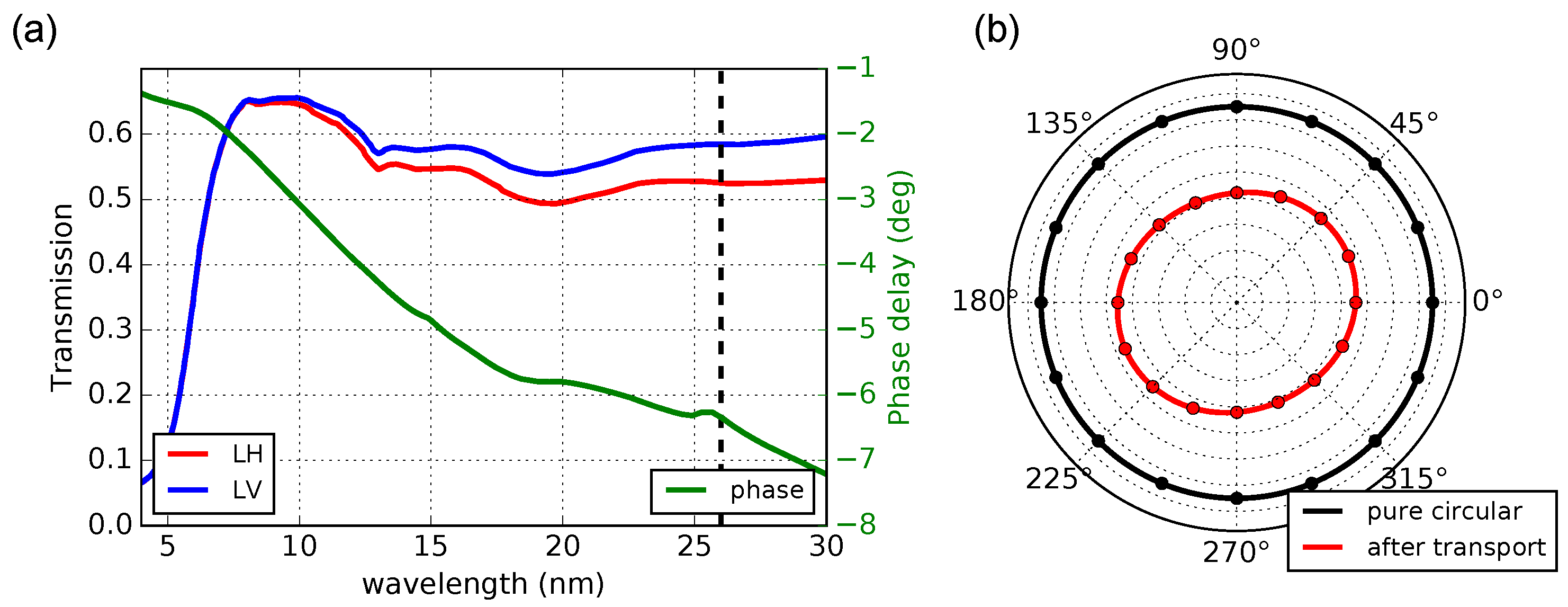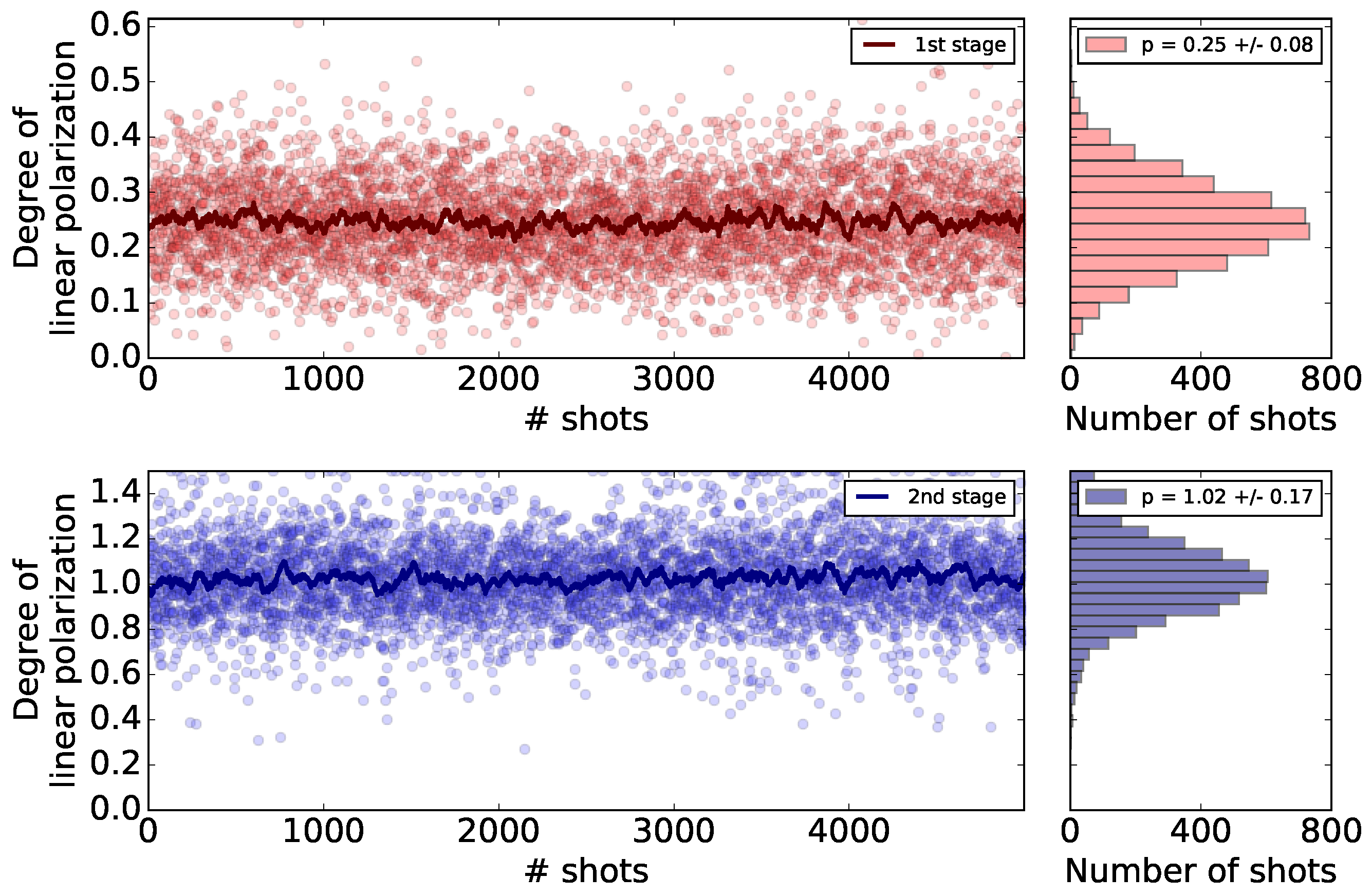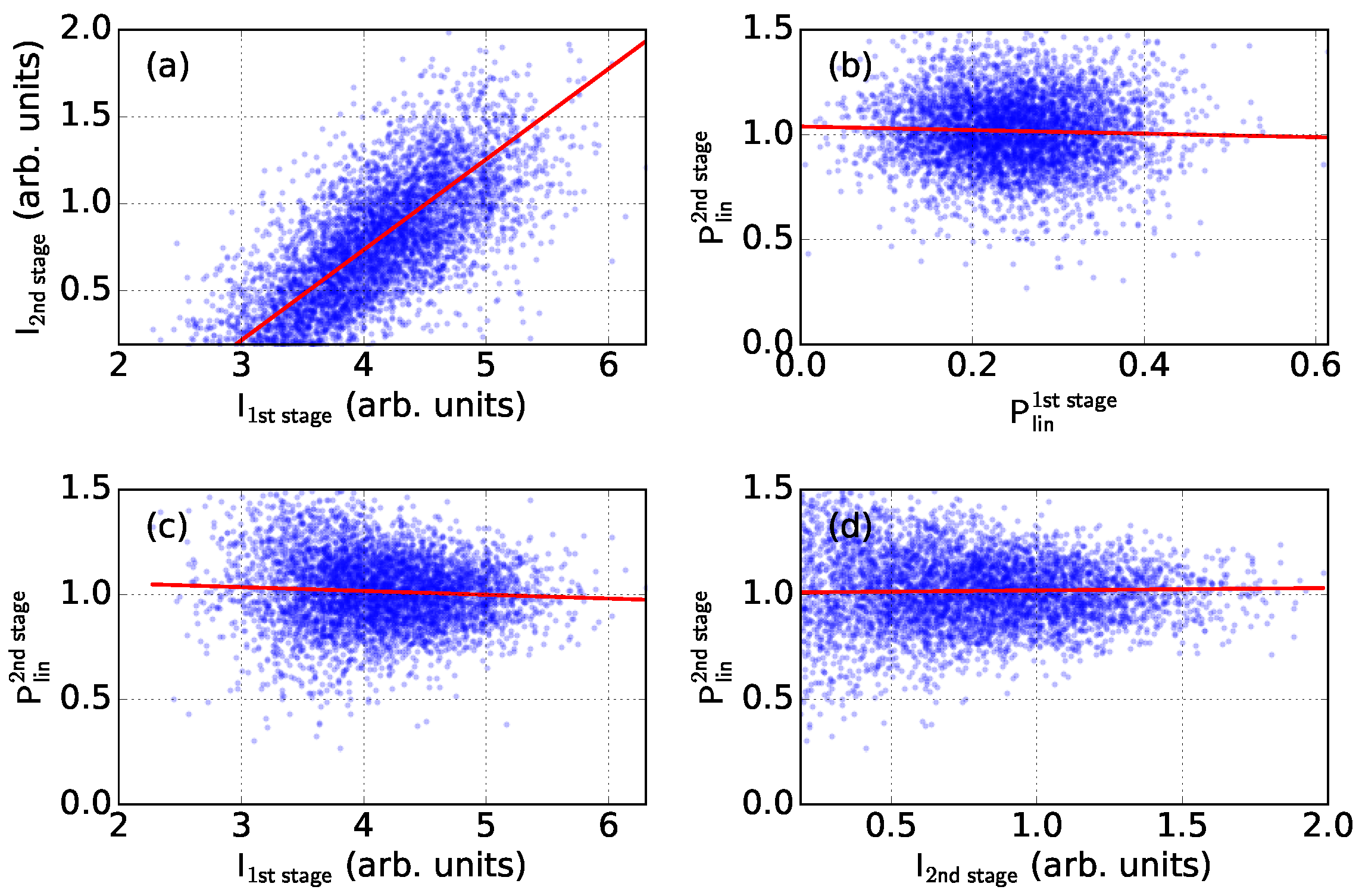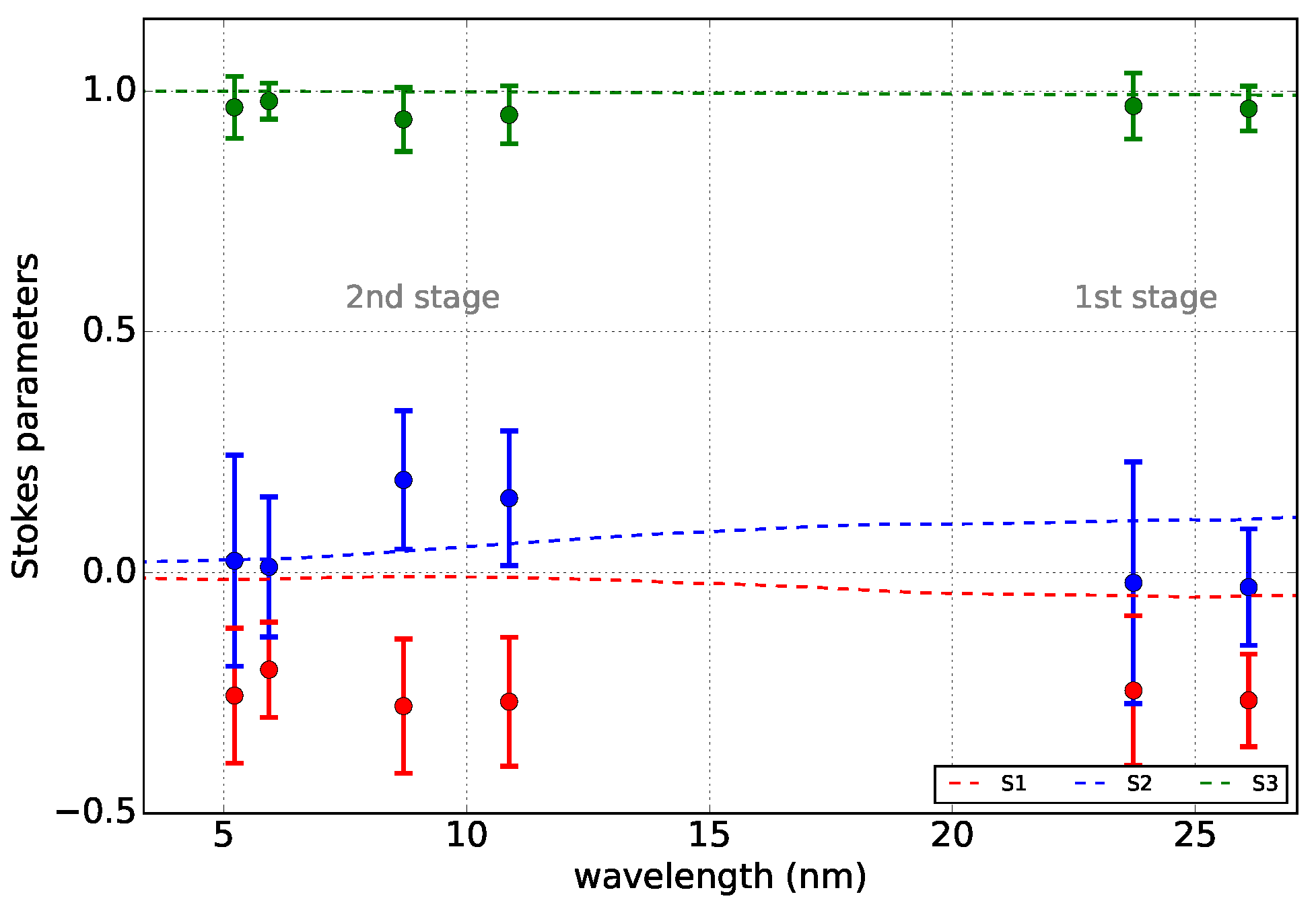Polarization Characterization of Soft X-Ray Radiation at FERMI FEL-2
Abstract
:1. Introduction
2. Materials and Methods
2.1. FERMI FEL-2
2.2. The Photon Beam Transport
2.3. The Electron Time-Of-Flight Polarimeter
3. Results and Discussion
4. Conclusions
Acknowledgments
Author Contributions
Conflicts of Interest
References
- Eisebitt, S.; Luning, J.; Schlotter, W.F.; Lorgen, M.; Hellwig, O.; Eberhardt, W.; Stohr, J. Lensless imaging of magnetic nanostructures by X-ray spectro-holography. Nature 2004, 432, 885–888. [Google Scholar] [CrossRef] [PubMed]
- Boeglin, C.; Beaurepaire, E.; Halte, V.; Lopez-Flores, V.; Stamm, C.; Pontius, N.; Durr, H.A.; Bigot, J.Y. Distinguishing the ultrafast dynamics of spin and orbital moments in solids. Nature 2010, 465, 458–461. [Google Scholar] [CrossRef] [PubMed]
- Von Korff Schmising, C.; Pfau, B.; Schneider, M.; Günther, C.M.; Giovannella, M.; Perron, J.; Vodungbo, B.; Müller, L.; Capotondi, F.; Pedersoli, E.; et al. Imaging Ultrafast Demagnetization Dynamics after a Spatially Localized Optical Excitation. Phys. Rev. Lett. 2014, 112, 217203. [Google Scholar] [CrossRef]
- Garcia, G.A.; Nahon, L.; Lebech, M.; Houver, J.C.; Dowek, D.; Powis, I. Circular dichroism in the photoelectron angular distribution from randomly oriented enantiomers of camphor. J. Chem. Phys. 2003, 119, 8781–8784. [Google Scholar] [CrossRef]
- Janssen, M.H.M.; Powis, I. Detecting chirality in molecules by imaging photoelectron circular dichroism. Phys. Chem. Chem. Phys. 2014, 16, 856–871. [Google Scholar] [CrossRef] [PubMed]
- Desiderio, D.; Difonzo, S.; Diviacco, B.; Jark, W.; Krempasky, J.; Krempaska, R.; Lama, F.; Luce, M.; Mertins, H.C.; Placentini, M.; et al. The ELETTRA circular polarization beamline and electromagnetic elliptical wiggler insertion device. Synchrotron Radiat. News 1999, 12, 34–38. [Google Scholar] [CrossRef]
- Bahrdt, J.; Frentrup, W.; Gaupp, A.; Scheer, M.; Gudat, W.; Ingold, G.; Sasaki, S. Elliptically polarizing insertion devices at BESSY II. Nucl. Instrum. Methods Phys. Res. Sect. A 2001, 467–468, 21–29. [Google Scholar] [CrossRef]
- Benabderrahmane, C.; Berteaud, P.; Briquez, F.; Couprie, M.E.; Chubar, O.; Dubois, L.; Filhol, J.M.; Girault, M.; Level, M.P.; Marcouillé, O.; et al. First SOLEIL insertion devices are ready to produce photons for users. Nucl. Instrum. Methods Phys. Res. Sect. A 2007, 575, 33–37. [Google Scholar] [CrossRef]
- Nahon, L.; de Oliveira, N.; Garcia, G.A.; Gil, J.F.; Pilette, B.; Marcouillé, O.; Lagarde, B.; Polack, F. DESIRS: A state-of-the-art VUV beamline featuring high resolution and variable polarization for spectroscopy and dichroism at SOLEIL. J. Synchrotron Radiat. 2012, 19, 508–520. [Google Scholar] [CrossRef] [PubMed]
- Wang, H.; Bencok, P.; Steadman, P.; Longhi, E.; Zhu, J.; Wang, Z. Complete polarization analysis of an APPLE II undulator using a soft X-ray polarimeter. J. Synchrotron Radiat. 2012, 19, 944–948. [Google Scholar] [CrossRef] [PubMed]
- Viefhaus, J.; Scholz, F.; Deinert, S.; Glaser, L.; Ilchen, M.; Seltmann, J.; Walter, P.; Siewert, F. The Variable Polarization XUV Beamline P04 at PETRA III: Optics, mechanics and their performance. Nucl. Instrum. Methods Phys. Res. Sect. A 2013, 710, 151–154. [Google Scholar] [CrossRef]
- Vodungbo, B.; Sardinha, A.B.; Gautier, J.; Lambert, G.; Valentin, C.; Lozano, M.; Iaquaniello, G.; Delmotte, F.; Sebban, S.; Lüning, J.; et al. Polarization control of high order harmonics in the EUV photon energy range. Opt. Express 2011, 19, 4346–4356. [Google Scholar] [CrossRef] [PubMed]
- Fleischer, A.; Kfir, O.; Diskin, T.; Sidorenko, P.; Cohen, O. Spin angular momentum and tunable polarization in high-harmonic generation. Nat. Photon. 2014, 8, 543–549. [Google Scholar] [CrossRef]
- Lambert, G.; Vodungbo, B.; Gautier, J.; Mahieu, B.; Malka, V.; Sebban, S.; Zeitoun, P.; Luning, J.; Perron, J.; Andreev, A.; et al. Towards enabling femtosecond helicity-dependent spectroscopy with high-harmonic sources. Nat. Commun. 2015, 6, 6167. [Google Scholar] [CrossRef] [PubMed]
- Pfau, B.; Günther, C.M.; Könnecke, R.; Guehrs, E.; Hellwig, O.; Schlotter, W.F.; Eisebitt, S. Magnetic imaging at linearly polarized X-ray sources. Opt. Express 2010, 18, 13608–13615. [Google Scholar] [CrossRef] [PubMed]
- Wang, T.; Zhu, D.; Wu, B.; Graves, C.; Schaffert, S.; Rander, T.; Müller, L.; Vodungbo, B.; Baumier, C.; Bernstein, D.P.; et al. Femtosecond Single-Shot Imaging of Nanoscale Ferromagnetic Order in Co/Pd Multilayers using resonant X-ray holography. Phys. Rev. Lett. 2012, 108, 267403. [Google Scholar] [CrossRef] [PubMed]
- Kim, K.J. Circular polarization with crossed-planar undulators in high-gain FELs. Nucl. Instrum. Methods Phys. Res. Sect. A 2000, 445, 329–332. [Google Scholar] [CrossRef]
- Deng, H.; Zhang, T.; Feng, L.; Feng, C.; Liu, B.; Wang, X.; Lan, T.; Wang, G.; Zhang, W.; Liu, X.; et al. Polarization switching demonstration using crossed-planar undulators in a seeded free-electron laser. Phys. Rev. Spec. Top. Accel. Beams 2014, 17, 020704. [Google Scholar] [CrossRef]
- Ferrari, E.; Allaria, E.; Buck, J.; De Ninno, G.; Diviacco, B.; Gauthier, D.; Giannessi, L.; Glaser, L.; Huang, Z.; Ilchen, M.; et al. Single Shot Polarization Characterization of XUV FEL Pulses from Crossed Polarized Undulators. Sci. Rep. 2015, 5, 13531. [Google Scholar] [CrossRef] [PubMed]
- Allaria, E.; Appio, R.; Badano, L.; Barletta, W.A.; Bassanese, S.; Biedron, S.G.; Borga, A.; Busetto, E.; Castronovo, D.; Cinquegrana, P.; et al. Highly coherent and stable pulses from the FERMI seeded free-electron laser in the extreme ultraviolet. Nat. Photon. 2012, 6, 699–704. [Google Scholar] [CrossRef]
- Allaria, E.; Castronovo, D.; Cinquegrana, P.; Craievich, P.; Dal Forno, M.; Danailov, M.B.; D’Auria, G.; Demidovich, A.; De Ninno, G.; Di Mitri, S.; et al. Two-stage seeded soft-X-ray free-electron laser. Nat. Photon. 2013, 7, 913–918. [Google Scholar] [CrossRef]
- Sasaki, S. Analyses for a planar variably-polarizing undulator. Nucl. Instrum. Methods Phys. Res. Sect. A 1994, 347, 83–86. [Google Scholar] [CrossRef]
- Temnykh, A.B. Delta undulator for Cornell energy recovery linac. Phys. Rev. Spec. Top. Accel. Beams 2008, 11, 120702. [Google Scholar] [CrossRef]
- Lutman, A.A.; MacArthur, J.P.; Ilchen, M.; Lindahl, A.O.; Buck, J.; Coffee, R.N.; Dakovski, G.L.; Dammann, L.; Ding, Y.; Dürr, H.A.; et al. Polarization control in an X-ray free-electron laser. Nat. Photon. 2016, 10, 468–472. [Google Scholar] [CrossRef]
- Capotondi, F.; Pedersoli, E.; Mahne, N.; Menk, R.H.; Passos, G.; Raimondi, L.; Svetina, C.; Sandrin, G.; Zangrando, M.; Kiskinova, M.; et al. Coherent imaging using seeded free-electron laser pulses with variable polarization: First results and research opportunities. Rev. Sci. Instrum. 2013, 84, 051301. [Google Scholar] [CrossRef] [PubMed]
- Müller, L.; Schleitzer, S.; Gutt, C.; Pfau, B.; Schaffert, S.; Geilhufe, J.; von Korff Schmising, C.; Schneider, M.; Günther, C.M.; Büttner, F.; et al. Ultrafast Dynamics of Magnetic Domain Structures Probed by Coherent Free-Electron Laser Light. Synchrotron Radiat. News 2013, 26, 27–32. [Google Scholar] [CrossRef]
- Mazza, T.; Ilchen, M.; Rafipoor, A.J.; Callegari, C.; Finetti, P.; Plekan, O.; Prince, K.C.; Richter, R.; Danailov, M.B.; Demidovich, A.; et al. Determining the polarization state of an extreme ultraviolet free-electron laser beam using atomic circular dichroism. Nat. Commun. 2014, 5, 3648. [Google Scholar] [CrossRef] [PubMed]
- Allaria, E.; Diviacco, B.; Callegari, C.; Finetti, P.; Mahieu, B.; Viefhaus, J.; Zangrando, M.; De Ninno, G.; Lambert, G.; Ferrari, E.; et al. Control of the Polarization of a Vacuum-Ultraviolet, High-Gain, Free-Electron Laser. Phys. Rev. X 2014, 4, 041040. [Google Scholar] [CrossRef]
- Allaria, E.; Badano, L.; Bassanese, S.; Capotondi, F.; Castronovo, D.; Cinquegrana, P.; Danailov, M.B.; D’Auria, G.; Demidovich, A.; De Monte, R.; et al. The FERMI free-electron lasers. J. Synchrotron Radiat. 2015, 22, 485–491. [Google Scholar] [CrossRef] [PubMed]
- Yu, L.H. Generation of intense uv radiation by subharmonically seeded single-pass free-electron lasers. Phys. Rev. A 1991, 44, 5178–5193. [Google Scholar] [CrossRef] [PubMed]
- Ben-Zvi, I.; Yang, K.; Yu, L. The “fresh-bunch” technique in FELS. Nucl. Instrum. Methods Phys. Res. Sect. A 1992, 318, 726–729. [Google Scholar] [CrossRef]
- Piseri, P.; Dipartimento di Fisica, Università degli Studi di Milano, Milano, Italy. Private communication, 2016.
- Fennel, T.; Institute of Physics, University of Rostock, Rostock, Germany. Private communication, 2016.
- Zangrando, M.; Cocco, D.; Fava, C.; Gerusina, S.; Gobessi, R.; Mahne, N.; Mazzucco, E.; Raimondi, L.; Rumiz, L.; Svetina, C. Recent results of PADReS, the Photon Analysis Delivery and REduction System, from the FERMI FEL commissioning and user operations. J. Synchrotron Radiat. 2015, 22, 565–570. [Google Scholar] [CrossRef] [PubMed]
- Svetina, C.; Cocco, D.; Mahne, N.; Raimondi, L.; Ferrari, E.; Zangrando, M. PRESTO, the on-line photon energy spectrometer at FERMI: Design, features and commissioning results. J. Synchrotron Radiat. 2016, 23, 35–42. [Google Scholar] [CrossRef] [PubMed]
- Svetina, C.; Grazioli, C.; Mahne, N.; Raimondi, L.; Fava, C.; Zangrando, M.; Gerusina, S.; Alagia, M.; Avaldi, L.; Cautero, G.; et al. The Low Density Matter (LDM) beamline at FERMI: Optical layout and first commissioning. J. Synchrotron Radiat. 2015, 22, 538–543. [Google Scholar] [CrossRef] [PubMed]
- Schäfers, F.; Mertins, H.C.; Gaupp, A.; Gudat, W.; Mertin, M.; Packe, I.; Schmolla, F.; Fonzo, S.D.; Soullié, G.; Jark, W.; et al. Soft-X-ray polarimeter with multilayer optics: Complete analysis of the polarization state of light. Appl. Opt. 1999, 38, 4074–4088. [Google Scholar] [CrossRef] [PubMed]
- Wang, H.; Dhesi, S.S.; Maccherozzi, F.; Cavill, S.; Shepherd, E.; Yuan, F.; Deshmukh, R.; Scott, S.; van der Laan, G.; Sawhney, K.J.S. High-precision soft X-ray polarimeter at Diamond Light Source. Rev. Sci. Instrum. 2011, 82, 123301. [Google Scholar] [CrossRef] [PubMed]
- Grizolli, W.; Laksman, J.; Hennies, F.; Jensen, B.N.; Nyholm, R.; Sankari, R. Multilayer based soft-X-ray polarimeter at MAX IV Laboratory. Rev. Sci. Instrum. 2016, 87, 025102. [Google Scholar] [CrossRef] [PubMed]
- Latimer, C.; MacDonald, M.; Finetti, P. A new method for polarization analysis in the VUV. J. Electron Spectrosc. Relat. Phenom. 1999, 101, 875–878. [Google Scholar] [CrossRef]
- Ilchen, M.; Glaser, L.; Scholz, F.; Walter, P.; Deinert, S.; Rothkirch, A.; Seltmann, J.; Viefhaus, J.; Decleva, P.; Langer, B.; et al. Angular Momentum Sensitive Two-Center Interference. Phys. Rev. Lett. 2014, 112, 023001. [Google Scholar] [CrossRef] [PubMed]
- Hartmann, G.; Lindahl, A.O.; Knie, A.; Hartmann, N.; Lutman, A.A.; MacArthur, J.P.; Shevchuk, I.; Buck, J.; Galler, A.; Glownia, J.M.; et al. Circular dichroism measurements at an X-ray free-electron laser with polarization control. Rev. Sci. Instrum. 2016, 87, 083113. [Google Scholar] [CrossRef] [PubMed]
- Codling, K.; Houlgate, R.G.; West, J.B.; Woodruff, P.R. Angular distribution and photoionization measurements on the 2p and 2s electrons in neon. J. Phys. B Atom. Mol. Phys. 1976, 9, L83. [Google Scholar] [CrossRef]
- Yao-Leclerc, I.; Brochet, S.; Chauvet, C.; De Oliveira, N.; Duval, J.P.; Gil, J.F.; Kubsky, S.; Lagarde, B.; Nahon, L.; Nicolas, F.; et al. Handling the carbon contamination issue at SOLEIL. Proc. SPIE 2011, 8077, 807712. [Google Scholar]








| Parameter | Value | Unit |
|---|---|---|
| Energy | 1.0/1.45 | GeV |
| Slice energy spread (rms) | 150 | keV |
| Slice transverse normalized emittance | ∼1.5 | mm.mrad |
| Peak current | 650 | A |
| Average beam transverse size | 125 | m |
| in the undulator (rms) | ||
| Electron beam magnetic delay line | 260 | fs |
| Repetition rate | 10 | Hz |
| Parameter | Value | Unit |
|---|---|---|
| Wavelength | 261.5 | nm |
| Bandwidth (FWHM) | 1.3 | nm |
| Pulse duration (FWHM) | 135 | fs |
| Available energy per pulse | ≤40 | J |
| Average beam size | 400 | m |
| in the modulator (rms) |
| 1st Stage Modulator | 1st Stage Radiatorsand 2nd Stage Modulator | 2nd Stage Radiators | |
|---|---|---|---|
| Magnetic period (mm) | 100 | 55 | 35 |
| Tuning range (nm) | 300–200 | 114–20 | 18–4 |
| Number of periods | 30 | 42 | 66 |
| Number of segments | 1 | 3 + 1 | 6 |
| Polarization | LH | LH, LV, CR, CL | LH, LV, CR, CL |
| Wavelength (nm) | FEL Polarization | () | ||||
|---|---|---|---|---|---|---|
| Circular right | ||||||
| Circular right | ||||||
| Circular right | ||||||
| Circular right | ||||||
| Circular right | ||||||
| Circular right | ||||||
| Linear horizontal | ||||||
| Linear horizontal | ||||||
| Linear horizontal | ||||||
| Linear vertical | ||||||
| Linear vertical |
© 2017 by the authors. Licensee MDPI, Basel, Switzerland. This article is an open access article distributed under the terms and conditions of the Creative Commons Attribution (CC BY) license (http://creativecommons.org/licenses/by/4.0/).
Share and Cite
Roussel, E.; Allaria, E.; Callegari, C.; Coreno, M.; Cucini, R.; Mitri, S.D.; Diviacco, B.; Ferrari, E.; Finetti, P.; Gauthier, D.; et al. Polarization Characterization of Soft X-Ray Radiation at FERMI FEL-2. Photonics 2017, 4, 29. https://doi.org/10.3390/photonics4020029
Roussel E, Allaria E, Callegari C, Coreno M, Cucini R, Mitri SD, Diviacco B, Ferrari E, Finetti P, Gauthier D, et al. Polarization Characterization of Soft X-Ray Radiation at FERMI FEL-2. Photonics. 2017; 4(2):29. https://doi.org/10.3390/photonics4020029
Chicago/Turabian StyleRoussel, Eléonore, Enrico Allaria, Carlo Callegari, Marcello Coreno, Riccardo Cucini, Simone Di Mitri, Bruno Diviacco, Eugenio Ferrari, Paola Finetti, David Gauthier, and et al. 2017. "Polarization Characterization of Soft X-Ray Radiation at FERMI FEL-2" Photonics 4, no. 2: 29. https://doi.org/10.3390/photonics4020029
APA StyleRoussel, E., Allaria, E., Callegari, C., Coreno, M., Cucini, R., Mitri, S. D., Diviacco, B., Ferrari, E., Finetti, P., Gauthier, D., Penco, G., Raimondi, L., Svetina, C., Zangrando, M., Beckmann, A., Glaser, L., Hartmann, G., Scholz, F., Seltmann, J., ... Giannessi, L. (2017). Polarization Characterization of Soft X-Ray Radiation at FERMI FEL-2. Photonics, 4(2), 29. https://doi.org/10.3390/photonics4020029









